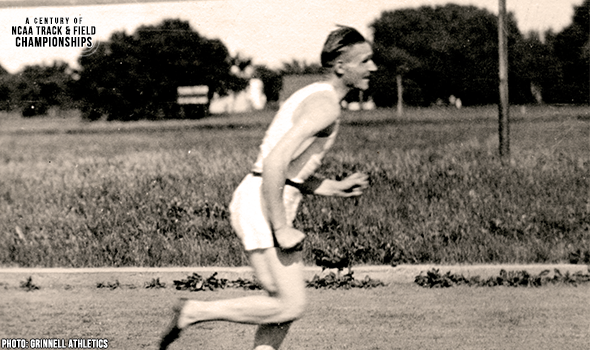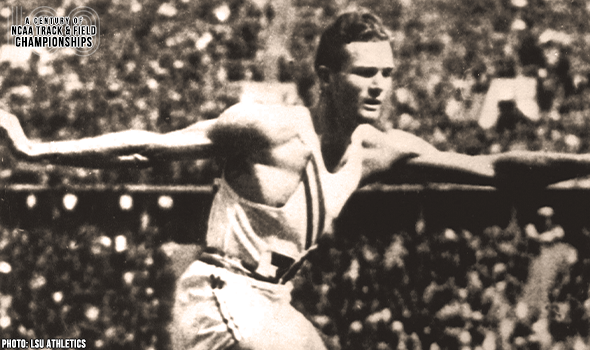
Stanford Romped To National Title in 1928
How good was Stanford’s 1928 NCAA championship team?
The Cardinal’s 72 points more than doubled the total of its closest challenger.
Stanford also had five different athletes win individual titles: That’s a combination no other program has yet matched in the same meet.
Adding to the impressiveness, all five of the Cardinal’s individual champions that year were (or would become) world record setters and/or Olympic medalists, and no points were scored by a sixth athlete with that same illustrious distinction.
Bud Spencer was captain of the squad and scored Stanford’s only points on the track, winning the 440 yards in a meet record 47.7. Spencer, who had broken the 400-meter world record at 47.0 a month earlier, had the fastest split on the U.S. 4×400 quartet that won gold with a world record in the 1928 Olympics later that summer.
Also setting a meet record – two, in fact – was pole vaulter Ward Edmonds with a final height of 13-6½ (4.13m). Earlier in the year, Edmonds had equaled the world record and became history’s third-ever 14-footer. Edmonds, who in 1929 became the first repeat NCAA vault champion with a co-title (and another MR at 13-8¾ or 4.18m), died suddenly in 1930 from polio at age 22.
Robert King won the high jump at 6-4½ (1.94m) and afterward was allowed to continue jumping, scaling a PR 6-6½ (1.99m). A month later, King would only need just 6-4¼ to earn the gold medal at the Olympics in Amsterdam.
Stanford could have won the meet just in the throwing events, where they earned 34 points (team runner-up Ohio State had 31), led by sophomore Eric Krenz with 18.
It was Krenz who actually got Stanford’s celebration started early, setting a meet record in the discus qualifying on the first day. His MR 149-2 (45.48m) carried over the next day to win the final and he added a runner-up effort in the shot put, losing to teammate Harlow Rothert.
For Rothert, another sophomore, it was the first of three-straight shot put titles to become the meet’s first three-time champion in a field event (Krenz was second each time). Both throwers were Olympians, though only Rothert would earn a medal – silver in the shot put in 1932, by which time teammate Krenz – a three-time world record setter in the discus – had died in a boating accident at age 25.
Not even scoring for Stanford was Ross Nichols, who finished sixth in the 120-yard hurdles but was disqualified for knocking over a hurdle. A month later, Nichols earned a similar DQ in the Olympic Trials 110-meter hurdles, in which he equaled the world record of 14.8 in the semifinals without knocking over any barriers.
The NCAA and collegiate track & field will mark a momentous milestone in the spring of 2021 -- the 100th anniversary of the NCAA Championships and with that, the NCAA Track & Field Championships. In June 1921, the University of Chicago hosted the first track & field championships in NCAA history.
This point can’t be emphasized enough: Not only was the event the first for NCAA track & field, but the first championships for any sport under the sponsorship of the NCAA.
To celebrate, over each of the next 365 days, the U.S. Track & Field and Cross Country Coaches Association (USTFCCCA) will celebrate moments, student-athletes, and coaches that have made a century’s worth of championships special. From humble beginnings to important historical milestones to the modern-day, collegiate track & field has evolved with the American society.
The 2021 edition of the NCAA Division I Outdoor Track & Field Championships begin with preliminary round action on May 27-29 in Jacksonville, Fla., and College Station, Texas. The championships final site and culmination of the celebration is slated for June 9-12, 2021 at the newly rebuilt Hayward Field in Eugene, Ore.

SIU’s Roggy Dominated The Javelin In 1978
Bob Roggy won the javelin title at the 1978 NCAA DI Outdoor T&F Championships by more than 20 feet. Roggy qualified first for the final with a MR heave of 89.30m (293‑0).

Makusha Made History In Bowerman Year Of 2011
Ngoni Makusha became just the fourth man in meet history to win individual titles in both the 100 and LJ. It was his 3rd career LJ crown and he set a CR in the 100 of 9.89.

George Mason’s Gage Shocked The NCAA LJ In 1988
Nena Gage won the long jump at the 1988 NCAA DI Outdoor T&F Championships in a shocking upset over Gail Devers.

Texas’ Thompson Marveled In NCAA Distance Events
Jerry Thompson won three career distance titles at the NCAA Outdoor T&F Championships. His first came in 1943. Then he won again in 1947 & 1948 after serving in World War II.

Grinnell’s Paulu Sprinted To NCAA History
Leonard Paulu was the first athlete to complete the 100-200 double in NCAA Outdoor Track & Field Championships history in 1922. That also made him the 1st to win back-to-back 100 titles, too.

Scott Won Back-To-Back NCAA Hammer Titles
Candice Scott won back-to-back hammer throw titles at the NCAA DI Outdoor T&F Championships in 2003 & 2004. Scott set a meet record of 69.77m (228-11) in that first year.

Drouin Soared To The Bowerman In 2013
Derek Drouin won two career HJ titles at the NCAA DI Outdoor T&F Championships. When Drouin won in 2013, he was only the fourth man to clear 2.34m (7-8) in meet history.

Watts Made Quick Work Of NCAA 400
Quincy Watts set a meet record in the 400 of 44.00 at the 1992 NCAA DI Outdoor Track & Field Championships. It lasted 25 years until 2017.

Iowa State’s Koll Rolled To 5K-10K Crowns
Lisa Koll won three career titles at the NCAA DI Outdoor T&F Championships in dominant fashion. Her average margin of victory in those 5K & 10K races was 37.73 seconds.

LSU’s Hardin Completed Unique 440-220H Double Twice
The nearly unheard of 440-220H double was so nice that Glenn Hardin did it twice! Hardin became the first to do so in meet history in 1933 and then swept them again in 1934.

